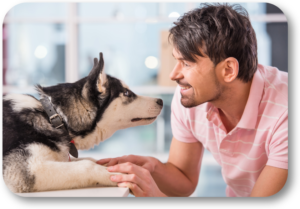Last week I was in Acworth working with a new Home Dog Training Client and Jamie, his Irish Setter. Jamie was a rescue dog and we believed he was about fourteen months old. His biggest problems were focused around trust and misbehavior. I worked on basic obedience commands to establish focus and instituting clear rules to create consistency. This helped Jamie understand that all was fine and that his owners were going to keep him safe.

Within a few hours Jamie clearly understood that he was in a strong and loving environment. Our client was overjoyed over the results and thrilled about the relationship he had established with Jamie.
Our client told me that Jamie was his first dog. With so many things he could do to be a great dog owner, he was confused about what was truly important. He asked us what he could do to make sure he was a great dog owner for Jamie…
I first congratulated our client for rescuing Jamie and offering a far better life than he probably had in the past. That act, alone, placed him on a positive journey to becoming a great dog owner.
I told him that my answer does not focus on behavioral or obedience issues he may have with his dog. It focuses on the basic things he needs to do as a “good person who has a dog”. So, let’s begin:
- Have your dog spayed or neutered as soon as possible. Dogs will live longer and have far less health issues if they are spayed or neutered. Unless you are going to show or breed them, “these parts” aren’t necessary. There are many different opinions regarding the appropriate time to spay or neuter your dog. I suggest that you talk to your veterinarian regarding the appropriate time.
- Make sure you have proper identification on your dog. We all do our best to “keep our dogs safely at home”, but life happens and they may get out. Make sure they are always wearing their collar and ID tag with your name and phone number. This will allow a neighbor to call you immediately when your dog ends up in their back yard. Have your dog chipped so that they can be “scanned” and quickly returned to you.
- Get a GPS device for your dog. This is similar to the “identification” discussion I just had above. The difference is that this will allow you to “see where your dog went”. You can attach a small GPS device to your dog’s collar and track them via an app on your cell phone.
- Provide your dog with proper training. Even though I said, “your dog”, you are normally the one needing most of the training. Besides teaching your dog to come, sit, or stay on command, the mere act of working with him will build a strong bond and establish trust between you and your dog.
- Get your dog into the Vet for regular check-ups. Finding issues early will assure that your dog will stay as healthy as possible for their entire life. It will also extend their life so you will have more quality time with him.
- Always arrange special time for you and your dog. Schedule play dates and involve him in your regular family activities. Your dog is a part of your family. Be sure he feels like he is an accepted and loved member.
- Keep your dog as active as possible. Exercise is a key activity for your dog. It keeps them healthy, allows them to socialize, and strengthens their bond with you. Play games like fetch. Take him for a walk. Hide goodies and encourage him to find it. Do anything that keeps him active. If you can’t devote thirty to sixty minutes a day for play, consider taking him to a Doggie Day Care when you are unavailable.
- Make sure your dog has proper shelter. Your dog should have his special place where he can go and “hang out”. A standard dog crate is a great choice for your dog’s shelter. Your dog should be the only one allowed in the crate. This will make it “his place” and he will always feel safe when he goes into his crate.
- Keep your dog safe when you travel. We always wear seat belts when we get in the car. The same should be true for our dog. Depending on the type of car you drive and the size of your dog, I suggest two options. First, you can keep him in a dog crate that is secured to the car. Second, I suggest a “doggie seat belt”. This is a specialized leash that is about one to two feet long. One end of the leash attaches to your car’s seat belt clip and the other end attaches to your dog’s collar or harness. When your dog is attached to the doggie seat belt, he has enough mobility for comfort but not enough to “fly around” and become injured.
It is your job to be a responsible dog owner. Although not complete, following the above guidelines will get you a long way to becoming one!
Please call Robin or me at (770) 718-7704 if you need any dog training help. We are blessed to have been your local dog training professionals for over seventeen years. We have trained over 5,000 great dogs and loving families and are ready to help you.

Follow Us!